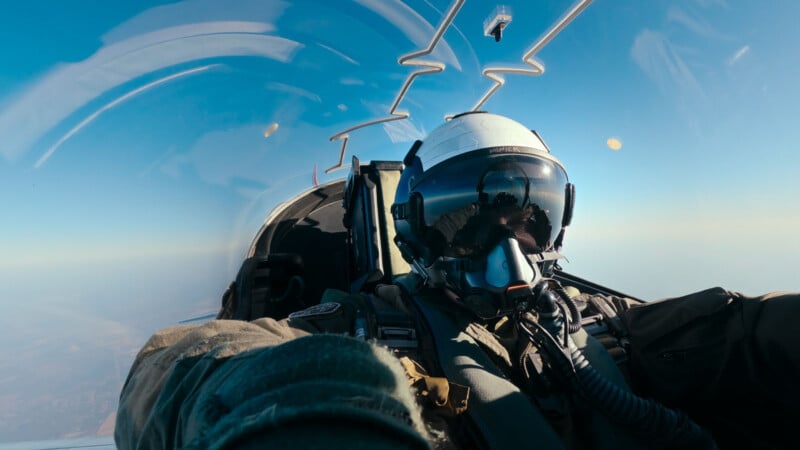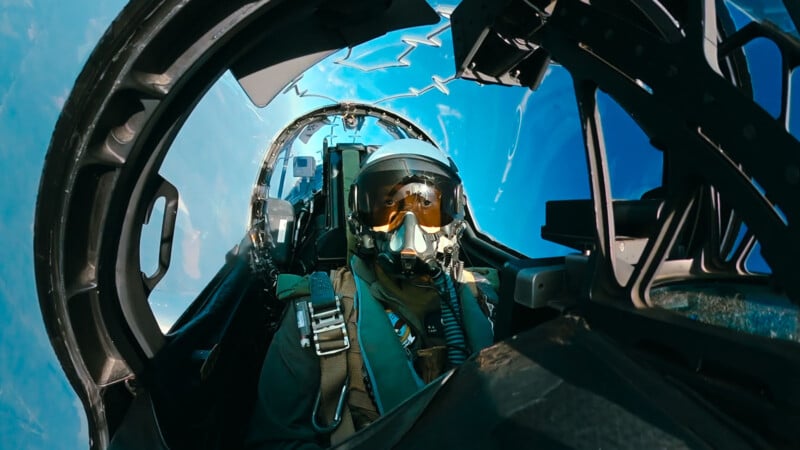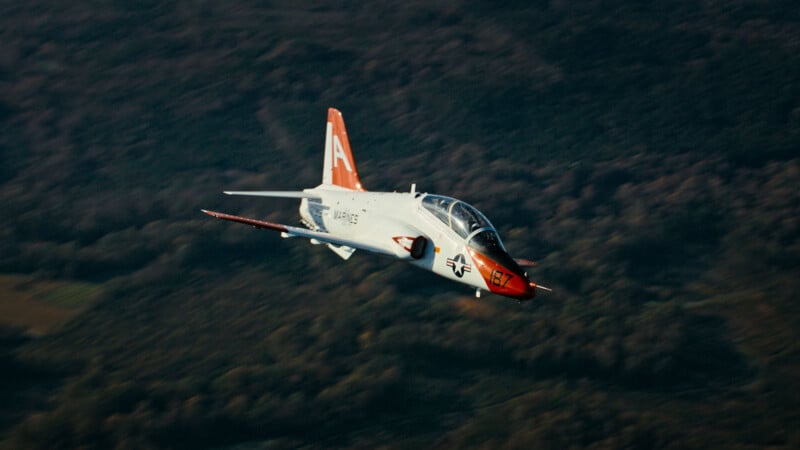Nat Geo’s New ‘Top Guns’ Series Puts Cameras Inside Fighter Jets
![]()
National Geographic‘s new documentary series, Top Guns: The Next Generation, combines thrilling visuals and takes viewers inside the U.S. Navy’s elite aviation program. Here’s how the team brought the incredible sights and sounds of fighter jet training to the small screen.
PetaPixel chatted with the cinematographer Jon Sayers about working Top Guns: The Next Generation and the camera tech he and the team used to capture the dynamism and speed of jets, including from inside the cockpit.
GoPro Cameras Save the Day
“The cockpit footage was recorded GoPros,” Sayers tells PetaPixel. “As you can imagine, the cockpits are very small spaces.”

The pilot and equipment take up considerable space, and there’s little room to spare inside a fighter jet cockpit.
“Using any large cameras in there would be very difficult,” Sayers explains. “So we had to work very careful with the Navy to design housings for the GoPros.”

Sayers and the cinematography team put two customized GoPros inside each plane, one facing out and the other looking back toward the pilot, capturing their experiences as they tear through the sky at breakneck speeds.
Sayers says that having the GoPro looking at the pilot helps the viewer get a better sense of what the experience inside the plane is like. Their reactions help convey the speed of everything better than outward-facing footage can, as there are not always solid reference points up in the air to provide that sense of speed.

Despite the relatively small sensors in GoPro cameras, Sayers came away extremely impressed by the little action cameras.
“You can never reproduce the effect of a large sensor and what it does for depth of field, and there are [limitations] with exposure and exposure latitude, and color reproduction,” Sayers explains. “But I was amazed at how good the GoPros were.”
When it came to matching the look of the GoPro footage to the large-format scenes, Sayers came away impressed. It took a lot of work during post-processing, but ultimately, the show delivers a consistent look regardless of the camera used.




Alongside the GoPros inside the planes, Sayers and his team shot extensively on the ground, including of the student pilots and their families. Many of these sequences were captured using large-format cinema cameras, including RED Raptors and DJI Ronin 4D units.
Plane-to-Plane Footage From the Team Behind Top Gun: Maverick
The show’s name is not just an homage to the famous Hollywood blockbuster, Top Gun and its sequel, Top Gun: Maverick. The creative team behind Maverick worked on the new docuseries for Nat Geo. The Top Gun: Maverick team helped capture aerial sequences, including plane-to-plane shots using Sony Venice rigs.
“They really knew what they were doing,” Sayers says of this separate air-to-air filming unit.

“We had a dedicated filming period for that,” Sayers explains, noting that these sequences, and many others in the show, were meticulously planned and storyboarded.
These sequences were carefully planned and then edited to fit with key moments during the story. After all, the series follows real Navy and Marine Corps student pilots as they experience the incredible highs and devastating lows of their training program. Not everyone makes the cut, and the entire process is exceptionally demanding both mentally and physically.

An Unusually Long Filming Period and Unprecedented Access
Sayers emphasizes that the entire project was very much a team effort, and everyone contributed immensely and helped everybody achieve their goals. This type of teamwork proved essential because the filming period for Top Guns: The Next Generation was unusually long.
It was a large-scale project shot for over a year. For much of that time, Sayers would spend about three out of every four weeks in the field shooting, and one week back home.


“It was a bit like a family,” Sayers recalls. “It was the same people nearly all the time.”
Although he didn’t want to call out any one person, since everyone was so vital to the production, Sayers did note that the sound department was especially crucial to his filming on this project.
“They’re crucial in observational filmmaking,” the cinematographer says. “We had a fantastic team doing that.”
Beyond working closely with the same people behind the scenes for a year, Sayers also worked closely with the subjects of the show, the students and their loved ones. He was there, camera in hand, to capture many emotional moments.
Sayers believes that spending so much time around the stars of the show helped him do a better job capturing their raw emotion and nailing every shot.
While he naturally enjoyed filming the happy moments the most, he says it was a privilege to be on hand for everything.

A particularly powerful part of the show is when students successfully perform their final test flights. These flights occur near the end of the day, and the light is always fantastic.
“They’re sprayed with a hose and there’s champagne sprayed everywhere. You can sense the sort of camaraderie and joy and relief,” Sayers says. “You’ve got beautiful light, and there is water everywhere, and ecstatic people going through something very emotional. It’s a perfect combination for cinematography. You’ve got all the elements, so those are my favorite moments.”
“It matters hugely,” Sayers says of how much time he spent around everyone during filming. “It really benefits the show because you care for these people and you know them. You’re alive to the nuances and subtleties and ticks of their character. You’re aware of their relationships with their family and other pilots and the instructors. It pays off because you understand what a little look will mean. You can only get that by spending time with people. Time is the crucial thing to have on your side.”
A Photographic Background
Sayers has decades of experience behind the camera as an acclaimed cinematographer. Like many accomplished cinematographers, he also has rich experience as a stills photographer.
While his professional career has been strictly in motion, his portfolio of still images reflects his deep understanding of visual storytelling and composition.
“I think motion and stills influence each other very strong,” Sayers tells PetaPixel. “But they’re quite different disciplines.”
“What you’re trying to do with documentary cinematography is capture a sequence of shots that allow you to tell the whole story of a particular situation. You’re going for great shots, but you’re also going for a lot of other stuff that will build the story. You have to think in sequences.”
Sayers knows that documentary photographers can think that way, too, but he believes there’s “slightly more emphasis” on going for incredible images in photography than in filmmaking.

“Documentary camera work is about waiting and listening and trying to capture the essence of what’s happening in front of you, give it another layer underneath — something special,” he says.
“I think there’s a different kind of listening that goes on with documentary camera work, perhaps,” he concludes.
Top Guns: The Next Generation Premieres This Week
Top Guns: The Next Generation premieres September 16 at 9 PM ET on National Geographic and will stream the following day, September 17, on Disney+ and Hulu. The series comprises six episodes, airing one episode weekly until the series finale on October 21.
Image credits: National Geographic